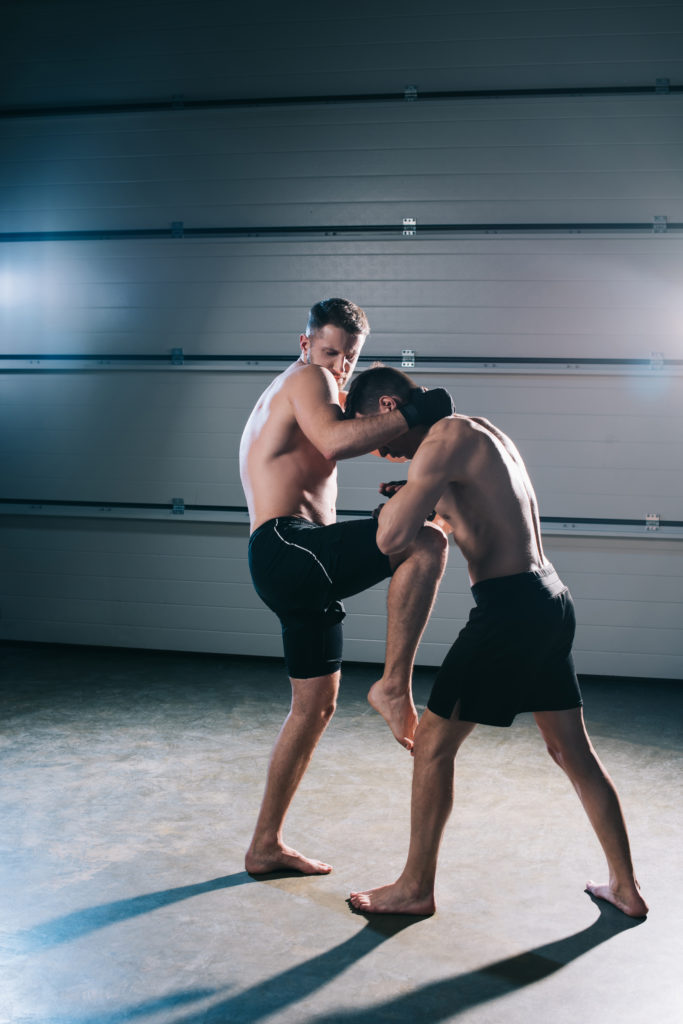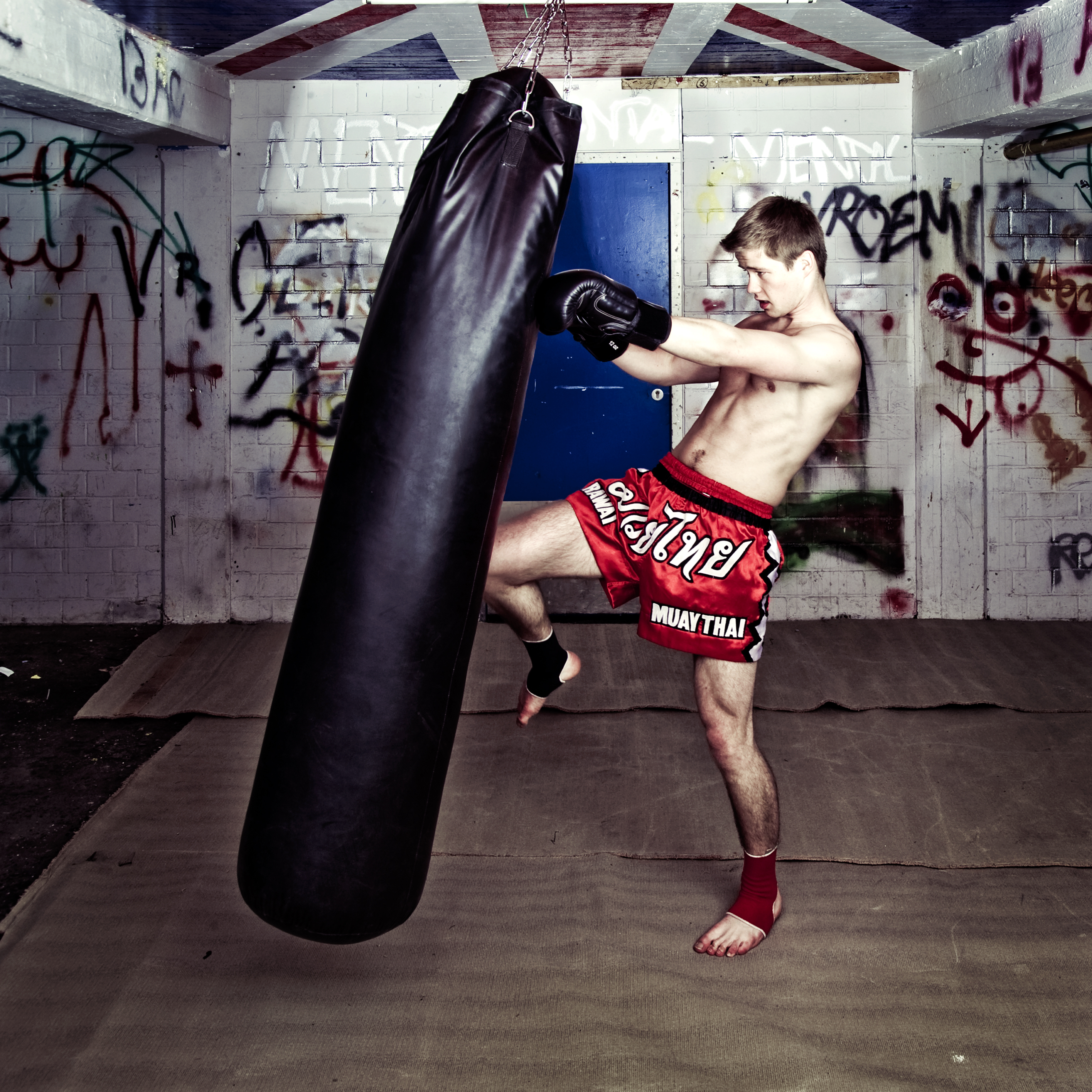The knee technique like many other strikes in muay thai, is not exclusive to muay thai and has been developed and trained in many other striking styles of martial arts.
In terms of combat sports, many popular sports forbid the use of knee techniques.
Muay thai and its related ‘cousins’, Lethwei and Khun Khmer as well as MMA allow the use of knees often with devastating effect and spectacular knee knockouts.
The development and training of the knee in muay thai is quite advanced in comparison to martial arts such as Krav Maga, Tae Kwon Do and Karate systems which train knee strikes to the groin as a good self defense technique but do not use them in competitive matches.
The Muay Thai Knee-Kick Ti Khao
The knee strike in muay thai is known as ti khao it has different English spelling variations such as dhee kow or ti kow. But translated literally it means knee-kick.
A knee-kick (ti khao) requires bending and raising your knee, then striking the target with either the point of your knee or the inner part of the knee-joint.
The toes of the striking knee are extended straight downwards and form a straight continuous line from the shin to the toes. This will increase the sharpness and power of the striking knee.
The development of the knee technique in muay thai has seen the emergence of at least 8 distinct and unique knee techniques that are used in the ring in muay thai commonly.
Here we will look at 4 of the basic knee techniques that have unique Thai names related to the execution and position of the knee.
4 Basic Knee Techniques
The basic forms of muay thai knee discussed in this post are:
- Straight Knee – Khao Trong
- Diagonal Knee – Khao Chiang
- Swing Knee – Khao Tod
- Knee Bomb/Long Knee – Khao Yao
1. Straight Knee – Khao Trong
The straight knee, khao trong is best executed in close range with one or both of our hands around your opponents head/neck/shoulder area.
The knee is thrusted straight up into your opponents abdomen or chest area while simultaneously pulling down on their head/neck/shoulder area – pulling them into your thrusted straight knee.
This technique is usually learned as one of the first knee techniques in muay thai and is executed with the Rear or Lead knee by following the basic steps below:
Rear Straight Knee (Khao Trong)
- From your basic stance, step a little forward and out with your lead leg.
- Lean your weight forward onto your lead foot
- There are different options for your hands. i) You can clinch your opponent around his head and neck with both hands and pull them down into the knee. ii) Swing your rear arm down to get power. iii) Place the rear arm in your opponents face or over their shoulder and pull down.
- Thrust your rear knee up straight into the target (stomach/chest area).
- As you thrust your rear knee up keep the rear toes pointed down forming one straight line from the knee – shin – toes.
- To get more thrust step up on your lead leg’s toes.
Lead Straight Knee
For the lead straight knee you first need to get the lead knee into the rear position. You do this by stepping forward with your rear leg or switching your feet quickly so that the lead leg now becomes the rear.
Once the feet are switched with the lead now becoming the rear you can follow the same steps as above for the rear knee.
The video below shows how to switch stance for the lead knee.
2. Diagonal Knee – Khao Chiang
The diagonal knee strikes from a sideways angle, similar to that of the hook punch or that of a roundhouse kick.
The diagonal knee is thrusted up and inwards into the target which is more on the side of the body of your opponent at the ribs. The diagonal knee can also be directed at the thigh or your opponent.
Generally these attacks on the side of your opponent are not able to be done with the straight knee.
Rear Diagonal Knee
The execution of the diagonal knee is similar to the round kick. The steps are as follows for the rear round knee:
- From basic stance – step forward a little with the lead leg. Lead foot turned out to open up the hips for the rear knee to swing up and in
- Weight goes forward onto the lead foot a little (lead foot should be turned out at this point).
- Pick up the rear leg by opening your rear hip out – angle the knee up and in (45 degree angle) with the point of the knee aiming at the target which is the side of your opponents torso.
- Step up on your lead toes and thrust your right hip up and in aiming with the point of the knee diagonally into the side of your opponents torso.
Similar to the straight knee the diagonal knee can be thrown from outside or inside the clinch.
The hand positioning is the same as the straight knee with the three options of:
- Clinch your opponent around their head and neck with both hands and pull them down into the knee.
- Swing your rear arm (same side arm as striking knee) down to get power – lead hand guards your face.
- Place the rear arm (same side arm as striking knee) in your opponents face or over their shoulder and pull down, Lead hand guards the face.
Lead Diagonal Knee
In order to get enough power in the lead diagonal knee strike you first need to switch your stance brining the lead knee to the rear. You do this either by stepping forward with your rear foot or switching stance quickly in place.
The same procedures would follow as above once your stance has been switched. Remember to open up the hip by turning the foot outwards on the stepping foot opposite to the striking knee.
3. Swing Knee – Khao Tod
The swing knee or round/curved knee is performed from in the clinch.
The curved motion is needed as the distance between you and your opponent is too close to throw a straight knee or diagonal knee. Usually in the clinch you are chest to chest with your opponent and your head is down and chin tucked to protect against elbows.
The swing knee is very common in muay thai matches and while it has less power it is used to wear down your opponent and to stay active and keep scoring and striking from in the clinch.
The curved knee or swing knee requires being up on the toes in the clinch with hips forward.
In the clinch the swing knee can be executed from:
- the “plum” position (both your arms around your opponents head/neck area – dominant position)
- the 50/50 position one arm around your opponents head/neck area and the other outside and over your opponents arm (your opponent has the same position on you)
- from double underhooks
Rear Swing Knee
The rear knee is executed as follows:
- From the clinch (either of the three positions discussed above)
- Generate momentum by swinging your lead foot to the middle of your opponents two feet – the rear leg swings out with hip open and knee and shin vertical to the ground
- The thigh of the lifted leg will be parallel to the ground and knee is up
- Hop back past centre a little with the planted foot and swing the rear knee into your opponents side targeting the high rib area and striking with the inside of the knee rather than the point of the knee
Lead Swing Knee
The lead knee would use the same mechanics as the rear knee as your feet are a little more square in the clinch for balance as opposed to your normal fighting stance.
Stuart Tomlinson in the video explains well how to generate momentum by hopping and swinging your knee. He demonstrates how to practice the swing knee on the heavy bag below.
4. Knee Bomb/Long Knee – Khao Yao
The knee bomb or long knee technique can be executed from long range, hence the name.
The long knee makes use of the powerful forward stepping motion from outside to explode up into the target.
In executing the long knee your bodyweight will lean back slightly to generate more thrust into the lifting knee. This leaning back motion allows you to counterbalance your weight and throw the long knee forward and up into the target.
The good thing is that this also leans your head back to avoid counter punches.
The hand position is similar to the straight and diagonal knee except the long knee is not usually performed with a full clinch on your opponent.
The video below from the MMA Shredded Channel shows 5 great examples of how to perform the long knee.
I like to perform this technique with both of my hands controlling my opponents hands, or one hand on their head, neck pulling them forward, or both hands on their head and neck pulling them down into the knee.

The long knee is executed as follows:
Rear Long Knee
- From outside position – take a longer step forward and slightly out.
- Your weight should be on your lead foot which will generate the thrust of your rear knee.
- Pick up your rear knee (toes pointed straight forming a straight line from knee – shin – toes)
- Step up on your lead toes
- Lean back slightly to counter weight and generate thrust and drive the knee explosively up and into the target.
Lead Long Knee
For the lead long knee you can take a long step forward with your rear leg so that your stance is now switched and your lead knee is now your rear knee.
From this position the execution is the same as described above.
You can also quickly switch your stance to bring your lead leg to the rear and execute the lead knee, returning to your normal stance after the knee is landed.
Basic Muay Thai Knees
As stated there are at least 8 unique knee techniques in muay thai.
We have just gone over 4 of the basic knees in this post. Each of these knees can be trained and drilled on the heavy bag to get the technique and mechanics perfected.
I will describe the more advanced knee strikes in an upcoming post – stay tuned and happy training!



